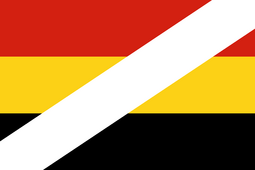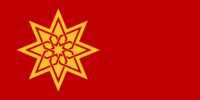Difference between revisions of "Flag of Kunjut"
Total pleb (talk | contribs) (Created page with "{{Infobox flag | Name = Kunjut | Image = Kunjut flag.png | Use = | Symbol = | Proportion = 3:2 | Adoption = 1964 | Design = A horizontal triband of red, yellow, and red, overlain with a white diagonal stripe. }} The '''flag of Kunjut''', also known as the '''Qamerez Flag''', has three equal horizontal stripes of red (top), yellow, and black, overlain with a white diagonal stripe spanning from the bottom-left to top-right corners. It was desi...") |
Total pleb (talk | contribs) m |
||
| Line 31: | Line 31: | ||
The official modern symbolism of the flag's colours is enshrined in Kunjut law. Red represents the blood of the people of Kunjut. Yellow represents the country's wealth, both natural and material. Black represents the fertile soil beneath every citizen's feet. White represents a ray of hope shining down on the country and its future. | The official modern symbolism of the flag's colours is enshrined in Kunjut law. Red represents the blood of the people of Kunjut. Yellow represents the country's wealth, both natural and material. Black represents the fertile soil beneath every citizen's feet. White represents a ray of hope shining down on the country and its future. | ||
However, on its original inception by Qamerez during the [[Kunjut Crisis]], and according to pro-independence militias who subsequently adopted the flag in honour of his martyrdom, the colours held political symbolism in opposition against both the [[Balak Empire]] and the [[Union of Shomosvan]]. Red represented Balak imperialism, yellow represented [[Kuulism]], black represented [[Sannism]], and the diagonal white stripe served to cross these out. The flag was | However, on its original inception by Qamerez during the [[Kunjut Crisis]], and according to pro-independence militias who subsequently adopted the flag in honour of his martyrdom, the colours held political symbolism in opposition against both the [[Balak Empire]] and the [[Union of Shomosvan]]. Red represented Balak imperialism, yellow represented [[Kuulism]], black represented [[Sannism]], and the diagonal white stripe served to cross these out. The flag was thus an anti-imperialist, anti-Kuulist, and anti-Sannist protest flag. | ||
==History of the Kunjut flag== | ==History of the Kunjut flag== | ||
Latest revision as of 11:04, 30 September 2023

| |
| Proportion | 3:2 |
|---|---|
| Adopted | 1964 |
| Design | A horizontal triband of red, yellow, and red, overlain with a white diagonal stripe. |
The flag of Kunjut, also known as the Qamerez Flag, has three equal horizontal stripes of red (top), yellow, and black, overlain with a white diagonal stripe spanning from the bottom-left to top-right corners. It was designed by pro-independence martyr Ayka Qamerez, and has been in continuous official use in its present form since 1964, one year after Kunjut formally achieved independence.
Colours and symbolism
| Scheme | Textile colour |
|---|---|
| Red | #D32011 |
| Yellow | #FCD116 |
| Black | #000000 |
| White | #FFFFFF |
The official modern symbolism of the flag's colours is enshrined in Kunjut law. Red represents the blood of the people of Kunjut. Yellow represents the country's wealth, both natural and material. Black represents the fertile soil beneath every citizen's feet. White represents a ray of hope shining down on the country and its future.
However, on its original inception by Qamerez during the Kunjut Crisis, and according to pro-independence militias who subsequently adopted the flag in honour of his martyrdom, the colours held political symbolism in opposition against both the Balak Empire and the Union of Shomosvan. Red represented Balak imperialism, yellow represented Kuulism, black represented Sannism, and the diagonal white stripe served to cross these out. The flag was thus an anti-imperialist, anti-Kuulist, and anti-Sannist protest flag.
History of the Kunjut flag
Balak Empire

Kunjut Crisis
Independence
Immediately following the country's formal independence in 1963, the national government hosted a flag design competition. The Qamerez Flag was adopted as a temporary measure, though it was also submitted by the government as an entry in the competition in the martyr's honour. Though several other designs proved popular, the Qamerez Flag attained first place, and was subsequently adopted as the official national flag in 1964.
